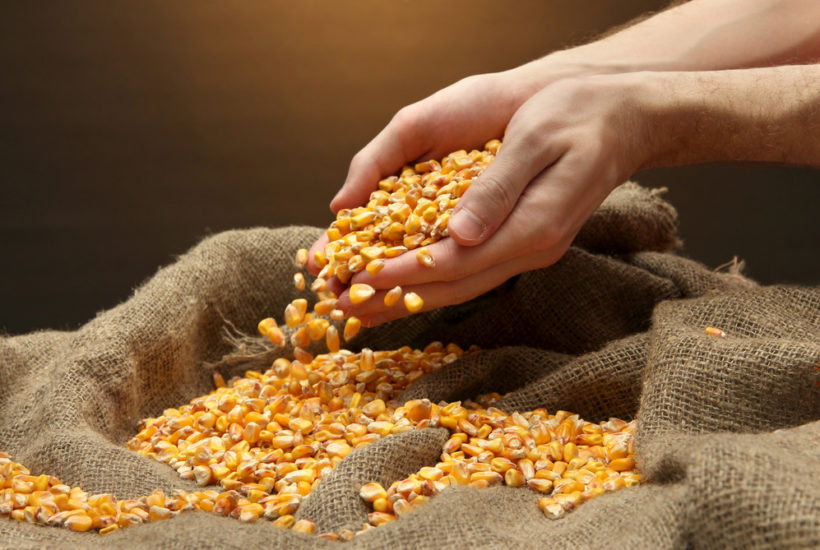Featured
Corn markets move higher with favorable weather conditions
Corn prices are going to be relatively strong in the coming weeks.

Wheat
Wheat markets were higher once again last week as traders talked about disease potential in Winter Wheat crops and about dry conditions in parts of Russia. Minneapolis Spring Wheat markets were also higher, but rallied less than the markets in Chicago due to ideas of better planting conditions for crops in the northern Great Plains and Canadian Prairies. There was more talk of disease problems for the Winter Wheat crops. There have been no confirmed reports of disease in the crops yet, but the weather has been good for promoting the disease. The areas most favored for the disease are the Midwest and eastern Great Plains where all of the rain has fallen.
The wet weather is also causing concerns about Winter Wheat quality as too much rain could hurt protein levels. This is a bigger problem for Hard Red Winter Wheat. It has been very dry in central Russia and into Kazakhstan, and there is talk that the crops will be hurt. It has also been dry in Australia. There are concerns developing about the northern European crops as hot and dry weather is expected to develop there. Demand has been the big problem for any bullish traders for the last year and demand has improved over the last few weeks. The demand is the past year has been disappointing as weaker prices have not improved sales. World prices have been stronger than those in the US due to less production in major world exporters such as Russia, Europe, and Australia. The outlook is for improved world production this year from competing producers so the chances for the US to sell a lot more Wheat into the world markets are fading.
Corn
Corn moved higher again last week as the weather market continued. Funds have been forced to cover short positions and are mostly done with this task now. The weather in the Corn Belt this weekend featured scattered storms and rains and cooler temperatures. Some dry days are coming now, but rain appears for much of the Midwest by the middle of the week and should last through the end of the week in areas mostly south of Interstate 80. There is still a lot of Corn to be planted and in some areas a lot of preparatory field work before planting can be done. There were about 38 million acres unplanted at the start of last week and it is unlikely that much headway was made last week. There could still be more than 30 million acres left to plant as prevent plant insurance dates have already passed or are coming in the next week. Some of the area will not get planted this year, the only question is how much.
A Bloomberg poll last week of market analysts suggested that 5 to 6 million acres of Corn might not get planted this year. Some analysts and producers also expect lower yields due to the late planting dates and extremely difficult conditions for planting this year. All this implies a tighter market supply situation going forward and decreased estimates for US ending stocks. That means prices should remain relatively strong and that runs in the nearby month to 475 on the weekly charts are still very possible. Prices should remain relatively strong until more is known about production potential later this Summer.
Soybeans and soybean meal
Soybeans and Soybean Meal were higher last week, but fell on Friday along with the grains as President Trump declared he was imposing tariffs on Mexico due to the immigration problems. The move brought immediate demand concerns as Mexico is the largest buyer by far of US ag products. In addition, it threw the fate of the new North American trade agreement into doubt, so it could affect relations with Canada, too. Many business and groups in the US are against the move, and Mexico has sent its economic minister to the US to try to smooth things over. In the meantime, planting delays continue across the Midwest as showers and storms were seen in the Midwest over the weekend and more are in the forecast starting about the middle of this week.
US weather remains poor for planting Soybeans as well as Corn and planting of both crops is well behind normal. Crop conditions for emergence and initial growth are also bad as it is too wet and too cold for best growth in much of the Midwest. Soybeans have been slower to react than Corn as most producers try to plant Corn first and because of the trade wars with China combined with increased potential for South America to take over the market at this time. The market is worried about overall Chinese Soybeans demand due to the Asian Swine Flu that has decimated the hog herd there. Trade negotiations appear to be on hold now, and China is now reported to be looking everywhere but the US for whatever products it needs.
Rice
Rice closed a little lower for the week after making new highs for the move. The weather showed improvement, especially in areas to the south and on into Texas. It has remained mostly wet in the Mid South, but there have been reports of Rice getting planted. Active progress is hoped for again this week, but there will be some acres from southern Missouri into Arkansas and Mississippi that will not get planted at all. Futures have broken through some resistance areas on the weekly charts and the charts now show the chance for prices to move significantly higher over time. However, the market has already rallied a lot without any kind of a significant correction, so a short term move lower is possible now.
The weak close on Friday suggests that this correction might be started. Ideas of planting delays in Rice and continued good export demand have been reasons to support futures. Exports were much improved last week, and the lack of production in South America makes stronger demand likely even as prices stay relatively strong. Growing areas near the Gulf Coast and in Texas are reporting better crop progress and mostly good conditions. Texas and some Louisiana crops have gone into flood. Producers are hoping now for about average yields as crops did get hurt due to the excessive weather seen earlier in the year.
Palm oil and vegetable oils
World vegetable oils markets closed higher last week. Palm Oil was a little higher on ideas of increased Chinese demand and news of good exports for the month of May. Production ideas remain high, so the market has not really been able to get much of an uptrend going and remains in a sideways range on the daily charts. Palm Oil has been the primary beneficiary of the buying on ideas that China could cut purchases of Soybeans in the world market due to the Asian Swine Flu epidemic in the country that is killing off a large part of the hog herd. They will be producing less Soybean Oil and could increase purchases of Palm Oil to compensate. They would most likely purchase Soybean Oil from Argentina as well, but will avoid buying in the US if at all possible. Canola was firm again last week. It has been dry in the Prairies, and this has allowed for rapid planting but slow and uneven emergence.
China has basically cut off purchases of Canadian Canola due to the dispute over the Huawei executive. Canada is appealing to the US to help it solve the issue since the arrest was made at the request of the US government. However, trade negotiations between the US and China have blown up in the last couple of weeks and there is probably little the US can do even if it wanted to. The US is taking further action to ban the use of Huawei equipment and parts in the US on industrial espionage charges so relations are bad again. The market has tried to become more stable in recent weeks, but faces strong headwinds in getting demand flowing again and avoiding big ending stocks.
Worries that low production and low planted area this growing season have started to support new crop prices. Soybean Oil was higher as the US government moved to increase the use of ethanol, but upside was somewhat limited as Crude Oil futures worked lower. US Soybean Oil faces increased competition in world markets from Argentina as its Soybeans are harvested and processed. Argentina will look to reclaim its position as the largest exporter of Soybean Oil in the world.
Cotton
Cotton was a little lower for the week as futures moved sharply lower on Friday. The market was hurt by the threats President Trump made to increase tariffs on Mexico due to the immigration problems along the southern border. It is another demand threat for Cotton that is already experiencing lost business potential with China and turkey and could get hurt if Vietnam is targeted for tariffs later on. The export sales report was strong in reaction to the recent lower prices in futures markets. Cotton planting progress has been on par with the five year average and ideas of big crops are keeping prices weaker. There are some concerns that the cold May weather from Texas to the East Coast might cause lower yields this Fall.
Also pressuring the market are forecasts for big production around the world. USDA sees no shortage of Cotton anywhere in the coming year. However, it could be that the Indian monsoon gets off to a slow start and production potential gets hurt there and din Pakistan. It has been dry so far and is turning hotter, but this is considered pre monsoonal weather. The lack of a deal with China means less potential to sell US Cotton there. China has bought in limited amounts from the US this year as it seeks to cover a short crop of its own. However, it has bought more from India and now can look to Brazil for supplies. The breakdown in trade negotiations between the US and China means that the US will likely have sold what it will sell to China this year, and that China could even cancel some previous purchases. The stock markets have been weaker as there were some new fears about the world economic health, and that meant Cotton futures had another reason for weaker prices.
Frozen concentrated orange juice and citrus
FCOJ was higher as speculators bought in anticipation of the hurricane season. The season started on June 1, and a tropical system formed in the Gulf of Mexico and threatened to bring some significant rains to the Houston area. This is away from any big citrus production, but the storm means that the season has started right on time. Trends are sideways to up on the daily charts and sideways weekly charts as the market looks at a big oranges crop and weak demand for FCOJ. USDA production estimates are above 70 million boxes and represent a remarkable recovery from the greening disease and the small crops of just a couple of years ago.
Inventories in Florida are still 17% above a year ago. That means that there should be no shortage of oranges available to the market to make FCOJ. The increase is coming from less demand and good, but weakening, imports along with the increased domestic production. Harvest progress should be strong as producers are getting the Valencias done to complete the harvest for the year. Fruit for the next crop is developing and are as big as golf balls. Crop conditions are called good. Irrigation is being used a few times a week to help protect crop condition. Mostly good conditions are reported in Brazil as the harvest there is active.
Coffee
Futures were higher for the week in both markets as the Real worked higher. There are reports that the government and congress in Brazil are finally working together to solve the public pension crisis. Resolution to this problem was a major plank in the election of the new government earlier in the year. The Brazil harvest is moving along at a slow pace. Reports indicate that the yields are not real strong and that the quality of the crop is poor due to extreme weather seen early in the growing season. Forecasts for cold air were made for southern Coffee areas of Brazil, but the temperature outlook was not cold enough to cause any concerns about damage to Coffee. It is at least a reminder of what time of year it is in Brazil and the potential for damage due to cold and freezing temperatures.
Buyers are now more actively pursuing other origins, especially for certified or higher end coffees. Roasters were scale down buyers on the extended down move and now have more than ample supplies in house or on the way. Prices are generally below to well below the cost of production for world producers, and prices are getting to that point for producers in Brazil and Vietnam. The inventory data from ICO and others shows ample supplies in the world market. Brazil had a big production year for the current crop, but the next crop should be less as it is the off year for production. The charts show that both markets could trade in a sideways to up pattern for now as the market looks at weather and production potential of the next crop.
Sugar
Futures closed near the highs of the week as the Real turned stronger. The move higher in the Real increased world prices, as did news that Brazilian processors prefer to make Ethanol for the domestic market rather than Sugar for the export market. Processing of Sugarcane in Brazil has been off to a slow start. The trade thinks that there is plenty of Sugar available to meet any demand, but the low totals demonstrated by UNICA so far have created some doubts. Chart patterns on the weekly charts are sideways to down in New York and sideways in London. The fundamentals still suggest big supplies, and the weather in Brazil has improved to support big production ideas. Demand seems to be average and routine.
There are concerns that the Indian monsoon will not be strong this year and that Sugarcane production could be hurt. It is hot and dry there so far, but there are signs that the monsoon is ready to develop. The government weather services there is looking for a normal monsoon, but many private forecasters expect less rain and warmer temperatures than normal. Very good conditions are reported in Thailand. Demand for Sugar has been average, and demand for ethanol is reported to be increasing.
Cocoa
Futures held strong for much of the week, but closed on a weaker not on Friday. The ICCO released its latest estimates on Friday and called for a slight increase in world production. It cited strong production in West Africa that would more than offset reduced production from Asia and Latin America. The mid crop harvest is active in West Africa and reports are generally positive, although some Nigerian producers have complained that the weather is not giving them the best conditions for top yields. Ivory Coast arrivals are strong as are exports. The weekly arrivals pace is about 15% higher than a year ago and is holding this level. Arrivals were reported strong in the rest of West Africa as well. Demand appears strong and the market saw stronger than expected grind data when the quarterly grind is released in the EU, North America, and Asia in the last month.
Growing conditions are generally good in West Africa. Periods of showers and cooler temperatures were beneficial, and most in West Africa expect a very good mid crop harvest. Cameroon and Nigeria are reporting less production and prices there are reported strong. Conditions appear good in East Africa and Asia, but East Africa has been a little dry as has Malaysia.
—
DISCLAIMER: This article expresses my own ideas and opinions. Any information I have shared are from sources that I believe to be reliable and accurate. I did not receive any financial compensation for writing this post, nor do I own any shares in any company I’ve mentioned. I encourage any reader to do their own diligent research first before making any investment decisions.

-

 Crowdfunding6 days ago
Crowdfunding6 days agoa2censo Expands Crowdfunding Access for SMEs and New Investors
-

 Impact Investing2 weeks ago
Impact Investing2 weeks agoGlobal Rift Over Fossil Fuels Blocks UN Environmental Agreement
-

 Markets1 day ago
Markets1 day agoRice Market Rebounds from Oversold Lows Amid Weak Demand
-

 Markets1 week ago
Markets1 week agoMixed Market Trends as Global Coffee Growing Conditions Improve

























